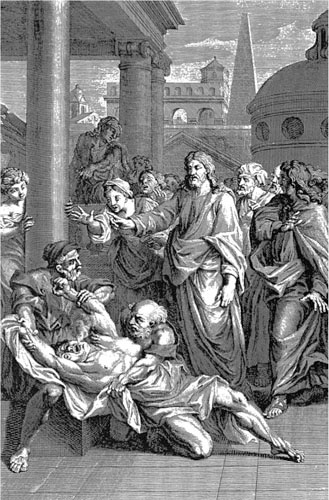
1 Christ expels an unclean spirit. The eighteenth-century Dutch artist Gerard Hoet depicts Christ healing the demoniac in the synagogue at Capernaum at the beginning of his public ministry. The engraving was included in a Dutch Bible to illustrate the exorcism text of Mark 1: 23.
2 Christ exorcising a demoniac. This thirteenth-century manuscript illustration depicts the demon as a man with wings who is addressing Christ. The image was intended to represent the exorcism at Capernaum, in which the demon asked Christ, ‘What have you to do with us, Jesus of Nazareth?’
3 St Eligius performing an exorcism. St Eligius (c. 590–659) was the bishop of Noyon. Painted in the fifteenth century by an anonymous artist, Eligius is shown praying, while two men are restraining the demoniac. The departing demon, depicted here as exceptionally large, has horns and bat wings.
4 St Catherine of Siena exorcizes a possessed woman. This seventeenth-century French engraving depicts St Catherine of Siena (1347–80) performing an exorcism of a female demoniac. Most exorcisms were performed by men, but Catherine's holiness qualified her for this role.
5 Exorcism of a young German woman in the fourteenth century. A sixteenth-century panel painting of an exorcism that took place in 1370 at the shrine of the Virgin Mary at Zell in Styria shows the exorcist has wrapped his stole around the woman's neck. The demoniac had been so tortured by the demons that she had killed her parents and infant, shown on the floor to the left. The numerous exorcised demons are leaving through the window.
6 The exorcism of Nicole Obry at the Cathedral of Laon in 1566. In the foreground Obry is being carried in a procession to the cathedral, while in the centre a crowd gathers below an improvised stage to witness different scenes of the exorcism. Near the top the exorcized demons are departing.
7 Administration of the Blessed Sacrament to Nicole Obry in 1566. French exorcists used the Eucharist in exorcisms as part of a propaganda campaign against the Huguenots to prove that Christ was really present in the Eucharist and that the Catholic Church was the one true Church established by Christ. Catholics considered both the Eucharist and exorcism to be miracles.
8 Execution of Urbain Grandier at Loudun in 1634. Grandier was one of three French priests convicted of causing the possession of nuns by means of witchcraft in the first half of the seventeenth century. The exorcism of the nuns takes place in the background.
9 St Ignatius of Loyola healing the possessed. This large painting by Peter Paul Rubens, originally placed above the altar in the Jesuit church at Antwerp in 1618, depicts St Ignatius, the founder of the Jesuit order, with one hand on the altar and the other raised to God. The people below him include a male and a female demoniac in the midst of their convulsions.
10 The exorcism of Madeleine Bavent in 1643. The first nun to be exorcised at Louviers, Bavent was subsequently accused of witchcraft, apostasy, sacrilege, and of having ‘lewdly prostituted her body’ to demons and warlocks at the witches' sabbath.
11 An Italian exorcism in the seventeenth century. This engraving by Jacques Callot depicts an unidentified woman during her exorcism. The woman's back is arched, her limbs are extended, and her head is twisted to her left. A picture of the Virgin Mary, whose help was often solicited in Catholic exorcisms, is in the background. The inscription explains that the demoniac's deliverance was attributed to this painting. The framing of the print in a proscenium arch gives the scene a dramatic character.
12 Christoph Haizmann's two paintings of the Devil. The Bavarian demoniac Christoph Haizmann, a painter working in Austria, made nine paintings to illustrate his encounters with the Devil. In the first painting, the Devil has four breasts and talons. In the second the Devil, holding the apple of temptation and smoking a pipe, exhibits human features, including multiple breasts, as well as the features of a goat.
13 The symptoms of hysteria I. Jean-François Badoureau depicts Louise Lateau, a patient in Jean-Martin Chacot's clinic, experiencing a hysterical attack in the late nineteenth century. The drawing shows the inflexibility of the woman's crossed legs and her extruded tongue. Charcot, who made the original sketch for the engraving, claimed that the symptoms of possession were the same as those of hysteria and that demoniacs in the early modern period were really suffering from hysteria.
14 The symptoms of hysteria II. Hysterics were observed arching their backs in the second stage of a hysterical attack, as depicted in this sketch of a patient in Charcot's clinic. Many demoniacs were reported to have demonstrated similar agility. The exercise was difficult but not impossible to perform.
15 Title page of A True and Fearefull Vexation of One Alexander Nyndge (London, 1615). The inclusion of images of actors on the title page of this possession narrative was probably intended to illustrate the connection between the Devil and the theatre. Alexander's brother Edward, who wrote the narrative, says that Alexander during his possession resembled the ‘picture of a Devil in a play’. Puritans objected to the theatre because male actors playing female roles, as depicted on this page, violated the biblical prohibition of transvestitism and because plays were considered to be the work of the Devil.
16 William Hogarth, Credulity, Superstition, and Fanaticism. The English artist William Hogarth has, here, satirized religious enthusiasm and the beliefs it inspired. Hogarth linked witchcraft, indicated by the witch on a broomstick held by a Methodist minister, and demonic possession, indicated by William Perry, the Boy of Bilson, vomiting pins beneath the lectern. The woman in the foreground delivering rabbits is Mary Tofts, who was believed to have delivered fourteen rabbits in 1726. By including her in this engraving, of 1762 Hogarth linked popular belief in ‘prodigies’ with the ‘irrational’ belief in possession and witchcraft.